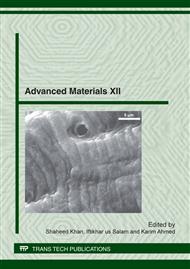p.221
p.227
p.233
p.241
p.248
p.255
p.261
p.265
p.271
Preparation, Structural and Electrical Properties of Nanocrystalline Zr-Mn Cobalt-Ferrite Synthesized by the Co-Precipitation Method
Abstract:
The present study describes the preparation, structural and electrical characterization of nanosized Zr-Mn cobalt-ferrites. The nominal compositions CoFe2-2xZrxMnxO4 (0.10.4) have been synthesized by the co-precipitation method. These nanopowder products were sintered in furnace at temperature of 800 °C for 8 hour with a heating rate of 10οC/min to obtain these ferrites. The nanopowder was evaluated using XRD, FT-IR and SEM. The XRD data showed that all the samples are of single phase and the crystallite size is found in the range of 2630 nm. The lattice constant (a), X-ray density (dx), porosity (P) and bulk density (dm) are also calculated from XRD data. FT-IR study confirms the presence of ferrite functional groups. The IR spectra of Zr-Mn ferrite system have been analyzed in the frequency range 400650 cm-1. It revealed two prominent bands υ1 and υ2 which are assigned to tetrahedral and octahedral metal complexes, respectively. The position of the highest frequency band is around 550 cm-1 while the lower frequency band is around 425 cm-1. The structural properties are also analyzed on scanning electron microscopy (SEM) at room temperature. Additionally, the dc electrical resistivity decreased with the rise in temperature for all the samples, showing a semiconductor like behavior. From the dc electrical resistivity the activation energy and drift mobility are determined. Both the drift mobility and activation energy increase with a rise in x.
Info:
Periodical:
Pages:
248-254
Citation:
Online since:
May 2012
Authors:
Keywords:
Price:
Сopyright:
© 2012 Trans Tech Publications Ltd. All Rights Reserved
Share:
Citation:


